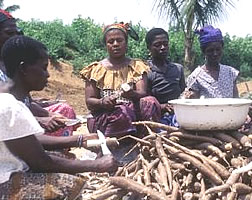This page has been archived and is being provided for reference purposes only. The page is no longer being updated, and therefore, links on the page may be invalid.
|
|
|
|
ARS to be Part of New Team Improving Cassava
By Kim KaplanJuly 11, 2005
Cassava, one of the most important food crops in Africa, is about to undergo an extreme makeover in a multimillion-dollar project that will include an Agricultural Research Service scientist as part of the interdisciplinary team.
ARS molecular biologist Edgar B. Cahoon's special responsibility will be increasing the cassava root's vitamin A and E content.
Cahoon, a member of the ARS Plant Genetics Research Unit, is located at the Donald Danforth Plant Science Center in St. Louis, Mo., where he collaborates with center scientists to enhance crop plants.
Ohio State University is leading the $7.5-million, 10-institution cassava improvement project, called "BioCassava Plus," under the direction of Richard Sayre. The grant runs for five years.
The Bill and Melinda Gates Foundation selected BioCassava Plus for one of the foundation's $450-million, "Grand Challenges in Global Health" program grants as an innovative solution to a global nutrition issue.
Cassava is the primary food source for more than 250 million Africans--about 40 percent of the continent's population. It is the most important crop in Africa, the fourth most important crop in the world, and relatively easy to grow in drought conditions. The plant's starchy root is a substantial portion of the diet of nearly 700 million people worldwide.
But cassava roots are low in protein and several micronutrients.
Team researchers will be developing cassava plants that have increased levels of zinc, iron, protein and vitamins A and E, plus longer shelf life and resistance to geminivirus. Danforth Center principal investigators Claude Fauquet, a cassava expert, and Daniel Schachtman, an expert in mineral nutrition, are other key participants in the project.
Once cassava varieties with higher vitamin A and E levels have been developed in the United States, they will be grown and tested for production and nutrient content under field conditions in Africa. Then the successful cassava cultivars will be released to breeding programs to be incorporated into finished varieties.
ARS is the U.S. Department of Agriculture's chief scientific research agency.


